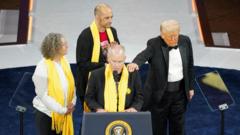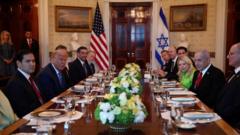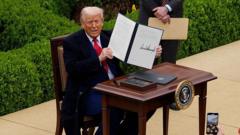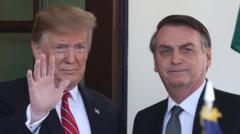In a notable escalation of trade tensions, President Trump declared a 25% tariff on Japanese and South Korean exports set to take effect on August 1. The announcement has sparked concerns in financial markets and among U.S. trading partners.
Trump Announces New Tariffs on Japan and South Korea, Worsening Trade Relations

Trump Announces New Tariffs on Japan and South Korea, Worsening Trade Relations
President Trump instigates a 25% tariff on exports from Japan and South Korea, as concerns rise over broader trade negotiations.
The market reacted sharply to President Trump’s latest tariff announcement, a 25% levy on exports from Japan and South Korea slated to begin on August 1. This move comes as part of a broader strategy that includes extensions and implementation of high tariffs on various countries, raising alarms among investors and trade analysts about the potential repercussions on the national economy and international relations.
In his communications, Trump detailed several additional tariffs affecting other countries, including 40% against Myanmar and Laos, 30% on South Africa, and 25% aimed at Kazakhstan and Malaysia. With these increased rates, financial markets were notably affected, suggesting a fear among investors over the implications of such high tariffs on trade dynamics.
For the past three months, the Trump administration has been engaged in complex negotiations with over a dozen nations to finalize trade agreements. To date, preliminary deals have only been established with Britain and Vietnam, while efforts with Japan and South Korea have been hindered by overlapping political events and ongoing tariff threats.
Both Japan and South Korea are reportedly cautious about negotiating with the Trump administration, apprehensive that any agreement could lead to further trade pressures in the future, especially concerning pivotal sectors like automobiles, steel, and electronics.
For further details, access Trump's letter directed to South Korean President Lee Jae-myung outlining the tariff imposition.
In his communications, Trump detailed several additional tariffs affecting other countries, including 40% against Myanmar and Laos, 30% on South Africa, and 25% aimed at Kazakhstan and Malaysia. With these increased rates, financial markets were notably affected, suggesting a fear among investors over the implications of such high tariffs on trade dynamics.
For the past three months, the Trump administration has been engaged in complex negotiations with over a dozen nations to finalize trade agreements. To date, preliminary deals have only been established with Britain and Vietnam, while efforts with Japan and South Korea have been hindered by overlapping political events and ongoing tariff threats.
Both Japan and South Korea are reportedly cautious about negotiating with the Trump administration, apprehensive that any agreement could lead to further trade pressures in the future, especially concerning pivotal sectors like automobiles, steel, and electronics.
For further details, access Trump's letter directed to South Korean President Lee Jae-myung outlining the tariff imposition.


















